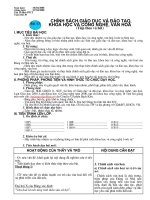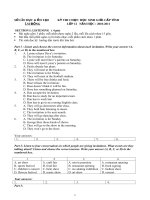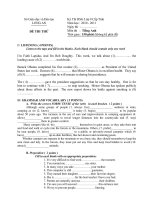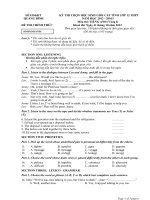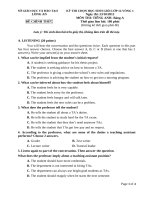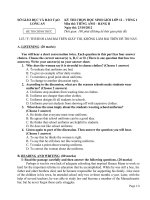Giáo trình tiếng anh lớp 12
Bạn đang xem bản rút gọn của tài liệu. Xem và tải ngay bản đầy đủ của tài liệu tại đây (30.66 MB, 200 trang )
Bộ GIáO DụC Và ĐàO TO
HOàNG VĂN VÂN (Tổng Chủ biên kiêm Chủ biên)
HOàNG TH XUÂN HOA ĐàO NGọC LộC Vũ TH LợI
Đỗ TUấN MINH NGUYễN QUốC TUấN
NHà XUấT BảN GIáO DụC
720-2007/CXB/531-1571/GD
M· sè: CH220M8
B¶n quyÒn thuéc Nhµ xuÊt b¶n Gi¸o dôc − Bé Gi¸o dôc vµ §µo t◊o
3
TIếNG ANH 12 đợc biên son dựa theo chơng trnh tiếng Anh
Trung học phổ thông của Bộ Giáo dục và Đào to, tiếp theo
Tiếng Anh 10, 11.
TIếNG ANH 12 đợc biên son theo chủ điểm (theme-based) gồm
16 đơn v bài học và 6 bài ôn. Mỗi đơn v bài học ứng với một
chủ đề cụ thể và gồm các mục lớn dới đây:
A. Reading: Gồm một hoặc một số đon văn có độ dài khoảng
hơn 300 từ, nhằm giúp học sinh làm quen với chủ đề của đơn v
bài học, cung cấp thông tin và ngữ liệu cho toàn đơn v bài học
và phát triển các kĩ năng đọc hiểu cho các em.
B. Speaking: Gồm các hot động luyện nói theo các chức
năng ngôn ngữ và theo các năng lực hay chủ đề của đơn v bài
học, đợc trnh bày qua các hnh thức hot động giao tiếp nh
thực hành nói theo cặp, thảo luận theo nhóm và nói cá nhân.
C. Listening: Gồm các đon văn hay các đon hội thoi liên
quan đến chủ đề bài học. Mục đch của mục này là nhằm rèn
luyện các kĩ năng nghe hiểu của học sinh, củng cố và chỉnh sửa
li những sai lệch trong phát âm và trong các cấu trúc ngôn ngữ
của học sinh.
D. Writing: Gồm các nhiệm vụ hay các hot động nhằm phát
triển kĩ năng viết tiếng Anh cho học sinh. Writing đợc biên
son dựa vào các chủ điểm và các thể loi nh viết th cá nhân,
th mời, miêu tả thông tin trong các biểu bảng, v.v...
LờI NóI ĐầU
LờI NóI ĐầU
4
E. Language Focus: Gồm hai mục chnh, Pronunciation và
Grammar (and vocabulary). Pronunciation giúp học sinh luyện cách
phát âm những phụ âm cuối từ, âm tiết có trọng âm trong những từ có
hai âm tiết trở lên, nhp điệu và các đờng nt ngữ điệu cơ bản trong
tiếng Anh. Grammar (and vocabulary) trnh bày những vấn đề về ngữ
pháp (và từ vựng) đợc cho là trọng tâm của đơn v bài học và của toàn
chơng trnh tiếng Anh lớp 12, giúp các em hiểu và sử dụng đợc từ ngữ
đúng và phù hợp trong giao tiếp.
Sáu bài ôn tập đợc trnh bày dới hnh thức Test Yourself và đợc
thực hiện sau mỗi chủ đề lớn theo quy đnh trong chơng trnh chuẩn của
Bộ Giáo dục và Đào to. Các Test Yourself đợc thiết kế để giúp học
sinh tự kiểm tra khả năng và sự hiểu biết của mnh sau khi các em đã học
xong từ hai đến ba đơn v bài học (nghĩa là sau từ 10 đến 15 tiết học).
Cuối sách là danh mục từ vựng đợc liệt kê theo từng đơn v bài học có
phiên âm và giải nghĩa tiếng Việt tơng đơng. Phần phiên âm đợc dựa
theo hệ thống các k hiệu phiên âm của từ điển Oxford Advanced Learners
Dictionary, in lần thứ 7, NXB Oxford.
Tập thể các tác giả hi vọng TIếNG ANH 12 sẽ mang li nhiều bổ ch cho
các em học sinh. Chúc các em thành công!
CáC táC Giả
5
6
Reading Speaking
Unit 1
Home Life
Page 12
●
Guessing meaning from
context
●
Passage comprehension
●
Asking and answering
about household chores
and family life
Unit 2
Cultural
Diversity
Page 20
●
Guessing meaning from
context
●
Passage comprehension
●
Talking about differences
among cultures
Unit 3
Ways of
Socialising
Page 30
●
Guessing meaning from
context
●
Summarising main idea
●
Passage comprehension
●
Practising giving and
responding to
compliments in different
situations
Unit 4
School
education
system
Page 44
●
Guessing meaning from
context
●
Scanning for specific
information
●
Passage comprehension
●
Talking about the school
education system in
Vietnam
Unit 5
Higher
education
Page 52
●
Vocabulary
comprehension matching
●
Passage comprehension
●
Arranging the sequence
of an event
●
Talking about the
application process to
tertiary institutions in
Vietnam
Unit 6
Future Jobs
Page 62
●
Guessing meaning from
context
●
Reading for specific
information
●
Giving opinions about
jobs
BOOK MAP ● BOOK MAP ● BOOK MAP ● BOOK MAP
7
Listening Writing Language Focus
●
Deciding on True or
False statements
●
Listening for specific
information
●
Writing about
family rules
●
Pronunciation:
− The pronunciation of
the ending ‘s’
●
Grammar:
− Tense revision
Dialogue:
●
Filling in missing
information
●
Comprehension
questions
●
Describing typical
features of a
Vietnamese
conical leaf hat
●
Pronunciation:
− The pronunciation of
‘ed’ endings
●
Grammar:
− Review of tenses
●
Deciding on True or
False statements
●
Gap-filling
●
Building sentences
based on given
words
●
Re-ordering given
sentences to make
a complete
paragraph
●
Pronunciation:
− Stress in two-syllable
words
●
Grammar:
− Reported speech
Dialogue:
●
Deciding on True or
False statements
●
Comprehension
questions
●
Describing school
education system
in Vietnam
●
Pronunciation:
− Stress in three-syllable
words
●
Grammar:
− Passive voice
Dialogue:
●
Deciding on True or
False statements
●
Comprehension
questions
●
Writing a letter of
request
●
Pronunciation:
− Stress in more than
three-syllable words
●
Grammar:
− Conditional sentences
Monologue:
●
Filling in missing
information
●
Deciding on True or
False statements
●
Writing a formal
letter of
job application
●
Pronunciation:
Weak/strong forms
of some conjunctions &
prepositions
●
Grammar:
Relative clauses
BOOK MAP ●BOOK MAP ●BOOK MAP ●BOOK MAP
8
Reading Speaking
Unit 7
Economic
Reforms
Page 74
●
Guessing meaning from
context
●
Deciding on True or False
statements
●
Passage comprehension
●
Scanning for specific
details
●
Describing details in
pictures
●
Talking about changes
the new economic reform
has brought about
Unit 8
Life in the
Future
Page 84
●
Guessing meaning from
context
●
Deciding on True or False
statements
●
Passage comprehension
●
Note taking
●
Talking about life in the
future
●
Discussing predictions
about life in the future
Unit 9
Deserts
Page 96
●
Guessing meaning from
context
●
Deciding on True or False
statements
●
Passage comprehension
●
Understanding the humour
of a funny story
●
Explaining why some
kinds of trees and
animals can exist in deserts
●
Talking about natural
features of deserts
●
Explaining why some
things should be brought
along while going across
a desert
Unit 10
Endangered
Species
Page 106
●
Guessing meaning from
context
●
Scanning for specific
details
●
Finding supporting
evidence
●
Asking and answering
questions about
endangered animals
●
Talking about the
information of some
endangered animals
Unit 11
Books
Page 118
●
Guessing meaning from
context
●
Deciding on True or False
statements
●
Passage comprehension
●
Asking and answering
about reading habits
●
Talking about characters
in a book
BOOK MAP ● BOOK MAP ● BOOK MAP ● BOOK MAP
9
Listening Writing Language Focus
●
Deciding on True or
False statements
●
Passage
comprehension
●
Writing a report
based on given
information
●
Pronunciation:
− Strong and weak forms
of auxiliaries
●
Grammar:
− (al)though/even though
●
Deciding on True or
False statements
●
Listening for details
●
Describing the
world you would
like to live in in
the future
●
Pronunciation:
− Contracted forms of
auxiliaries (continued)
●
Grammar:
− Prepositions and articles
●
Deciding on True or
False statements
●
Gap-filling
●
Describing main
features of a desert
●
Pronunciation:
− Full and contracted
forms of auxiliaries
●
Grammar:
− So, but, however and
therefore
Monologue:
●
Extensive listening:
Multiple-choice
questions
●
Gap-filling
●
Writing about
measures to
protect endangered
species and
possible results
●
Pronunciation:
− Rhythm
●
Grammar:
− Modal verbs: may,
might, must, mustn’t,
needn’t
●
Multiple choice
exercises
●
Gap-filling
●
Describing a book
●
Pronunciation:
− Rhythm
●
Grammar:
− Modals in the passive
voice
BOOK MAP ●BOOK MAP ●BOOK MAP ●BOOK MAP
10
BOOK MAP ● BOOK MAP ● BOOK MAP ● BOOK MAP
Reading Speaking
Unit 12
Water Sports
Page 128
●
Guessing meaning from
context
●
Passage comprehension
●
Reading for specific
information
●
Talking about types of
water sports
●
Giving opinions and
preferences about
water sports
Unit 13
THE 22
nd
SEA
GAMES
Page 138
●
Vocabulary: Giving
Vietnamese equivalents
to words & phrases
●
Scanning for specific
information
●
Passage comprehension
●
Talking about sports
events of the 22
nd
SEA
Games
●
Talking about (reporting)
sports results
Unit 14
International
organizations
Page 152
●
Vocabulary
comprehension matching
●
Passage comprehension
●
Talking about international
organizations and their
activities in charity and
volunteer work
Unit 15
Women in
society
Page 162
●
Guessing meaning from
context
●
Summarising main idea
●
Passage comprehension
●
Expressing opinions
●
Expressing degrees of
agreement
Unit 16
THE
ASSOCIATION OF
SOUTHEAST
ASIAN NATIONS
Page 172
●
Vocabulary
comprehension
●
Gap-filling
●
Deciding on True or False
statements
●
Passage comprehension
●
Talking about the
names of ASEAN
countries and their capitals
●
Talking about the
main characteristics of
each nation
11
Listening Writing Language Focus
Monologue:
●
Multiple-choice
questions
●
Comprehension
questions
●
Giving instructions
●
Pronunciation:
− Elision
●
Grammar:
− Transitive verbs
− Intransitive verbs
Monologue:
●
Comprehension
questions
●
Deciding on True or
False statements
●
Describing a
sporting event
(a football match)
●
Pronunciation:
− Linking
●
Grammar:
− Comparative + and +
comparative
− The + comparative,
the + comparative
Monologue:
●
Deciding on
True/False statements
or no information
●
Comprehension
questions
●
Writing a short
description
of an international
organization
●
Intonation:
− The falling tune
●
Grammar:
− Phrasal verbs
Monologue:
●
Extensive listening:
Multiple-choice
questions
●
Passage
comprehension
●
Describing a chart
●
Intonation:
− The rising tune
●
Grammar:
− Phrasal verbs (continued)
Dialogue:
●
Multiple-choice
questions
●
Comprehension
questions
●
Writing a letter of
recommendation
●
Intonation:
− The rising-falling tune
●
Grammar:
− Adverbial clause of
time
BOOK MAP ●BOOK MAP ●BOOK MAP ●BOOK MAP
A. READING
Before you read
Work in pairs. Ask and answer these questions about the picture.
1. Where is the family?
2. What is each member of the family doing?
3. Is the family happy? Why (not)?
12
HOME LIFE
Unit
1
While you read
Read the passage and do the tasks that follow.
I come from a family of five people: my parents, my two younger
brothers and I. My mother works as a nurse in a big hospital. She has to
work long hours and once a week she has to work on a night shift.
My father is a biologist. He works from 8 a.m. to 5 p.m. in a lab, but
sometimes when there is a project, he doesn’t come home until very late
at night. Although my parents are very busy at work, they try to spend
as much time with their children as possible. It is generally believed that
“men build the house and women make it home”, but in my family,
both parents join hands to give us a nice house and a happy home.
My mother is a very caring woman. She takes the responsibility for
running the household. She is always the first one to get up in the
morning to make sure that we leave home for school having eaten
breakfast and dressed in suitable clothes. In the afternoon, after
hospital, she rushes to the market, then hurries home so that dinner is
ready on the table by the time Dad gets home. Dad is always willing to
give a hand with cleaning the house. Unlike most men, he enjoys
cooking. Sometimes, at weekends, he cooks us some special dishes.
His eel soup is the best soup I have ever eaten.
I am now in my final year at the secondary school, and in my attempt
to win a place at university, I am under a lot of study pressure.
However, being the eldest child and the only daughter in the family
I try to help with the household chores. My main responsibility is to
wash the dishes and take out the garbage. I also look after the boys,
who are quite active and mischievous sometimes, but most of the time
they are obedient and hard-working. They love joining my father in
mending things around the house at weekends.
We are a very close-knit family and very supportive of one another.
We often share our feelings, and whenever problems come up, we
discuss them frankly and find solutions quickly. We always feel safe
and secure in our family. It is a base from which we can go into the
world with confidence.
13
Task 1. Choose the sentence A, B or C that is nearest in meaning to the
sentence given.
1. He doesn’t come home until very late at night.
A. He never comes home late at night.
B. He comes home late at night.
C. He sometimes comes home late at night.
2. “Men build the house and women make it home”.
A. Both men and women are good at building houses.
B. Men and women have to live separately.
C. Men’s responsibility is to work and support the family and
women’s job is to look after the family.
3. Our parents join hands to give us a nice house and a happy home.
A. Our parents work together to give us a nice house and a happy home.
B. Our parents take each other’s hands when they give us a nice
house and a happy home.
C. Our parents shake hands when they give us a nice house and
a happy home.
4. The boys are mischievous sometimes.
A. The boys are well-behaved sometimes.
B. The boys enjoy playing tricks and annoying people sometimes.
C. The boys miss their parents sometimes.
5. We are a very close-knit family.
A. Members of our family have very close relationships with each other.
B. Members of our family need each other.
C. Members of our family are never close to each other.
Task 2. Answer the questions.
1. How busy are the parents in the passage?
2. How caring is the mother?
3. How do the father and the daughter share the household chores?
4. What is the daughter attempting to do after secondary school?
5. Why do the children feel they are safe and secure in their family?
After you read
Work in groups. Compare the family described in the text with your
own family.
14
B. SPEAKING
Task 1. Read the following sentences and tick (✓) the ones that apply
to you and your family.
1. In my family, only my father works.
2. Members of my family share the household chores.
3. My responsibility in the family is to wash the dishes.
4. In my family, the interest we share closely is watching football.
5. I often share my personal secrets with my father.
6. I always talk to my parents before making an important decision.
Task 2. Work in pairs. Prepare a list of questions to ask another student
to find out whether his/her family life is like yours. You want to know:
●
who works in the family
●
who does the household chores
●
your friend’s responsibility in the family
●
the interest the family members share closely
●
the person your friend often shares his/her secrets with
●
the person your friend talks to before making an important decision
Example:
Who works in your family?
Task 3. Work with a different partner. Use the questions you have formed
to ask your partner about his/her family life. Note down the answers in the table.
Task 4. Go back to your original pairs. Tell each other the information
you have collected.
Example:
I talked to Tam. Both his parents work. But only his mother does the
household chores. ...
15
who works in the family
both parents
who does the household chores
your friend’s responsibility in the family
the interest the family members share closely
the person your friend often shares his/her secrets with
the person your friend talks to before making an
important decision
C. LISTENING
Before you listen
Look at the picture below and describe what is happening in it.
●
Listen and repeat.
flight reserved coach rarely
close-knit spread out leftovers crowded
While you listen
Task 1. Listen to the conversation between Paul and Andrea and decide
whether the statements are true (T) or false (F).
TF
1. Andrea can’t wait for her flight.
2. Paul is very excited about coming home.
3. Paul’s home is 280 kilometres from where they are now.
4. There are more children in Andrea’s family than in Paul’s.
5. When Andrea’s family get together, they often go out for dinner.
16
Task 2. Listen again and note down two things that are different about
Paul’s and Andrea’s families.
After you listen
Work in groups. Discuss the importance of family in a person’s life.
D. WRITING
Writing about family rules
Task 1. Work in groups. What rules do you have in your family?
Discuss these topics and add others. Use the following verbs and
expressions:
let, allow, be allowed to, have to, permit, etc.
●
doing household chores
●
coming home late
●
preparing meals
●
watching TV
●
talking on the phone
●
using the family motorbike
●
going out with friends
●
______________________
●
______________________
Example:
−
During the school year, I’m not allowed to watch TV until I have
finished my homework.
−
In my family, everybody has to do their share of the household chores.
Task 2. Use the ideas you have discussed above to write a letter to a
pen pal about your family rules. Begin as follows.
Every family has its own rules. Mine has a few. First, ……
17
Paul Andrea
1.
2.
E. LANGUAGE FOCUS
Pronunciation
●
Listen and repeat.
/s/ /z/
bats bags
kits kids
speaks speeds
dates days
photographs halves
●
Practise reading these sentences.
1. I saw some bats flying from the bags.
2. He often speaks at different speeds.
3. She tore the photographs into halves.
4. I always have dates on rainy days.
5. The kids are playing with their toy kits.
Grammar
Exercise 1. Underline the most suitable tense form in each sentence.
1. Did you see/Have you seen my bag anywhere? I can’t find it.
2. Hello Peter, are you back from the match? Did you enjoy/Have you
enjoyed it?
3. This is the photo of my great grandfather. He was/has been married
six times.
4. Have you given/Did you give Helen my message when you have
seen/saw her?
5. Sorry, could you say that again? I didn't listen/haven't listened to you.
6. Did you two meet/Have you two met before? Laura, this is Peter.
7. Did you meet/Have you met anyone interesting at the party?
●
Pronunciation: The pronunciation of the ending ‘s’
●
Grammar:
Tense revision: past simple, past progressive and present perfect
18
Exercise 2. Decide which answer (A, B or C) best fits each space.
(1) A. don’t write B. haven’t written C. am not writing
(2) A. was being B. am C. have been
(3) A. had B. was having C. have had
(4) A. haven’t done B. don’t do C. wasn’t doing
(5) A. stop B. have stopped C. was stopping
(6) A. wait B. am waiting C. have waited
(7) A. am changing B. have changed C. will change
(8) A. will live B. have lived C. live
(9) A. decided B. have decided C. decide
(10) A. will become B. becomes C. has become
(11) A. tells B. told C. was telling
(12) A. have moved B. was moving C. moved
(13) A. will come B. came C. come
(14) A. am staying B. stayed C. stay
(15) A. have gone B. am going C. will have gone
19
Dear Linda,
I’m sorry I (1) ___B___ to you for so long, but I (2) ______ very
busy lately. All last month I (3) ______ exams, and I (4) _____
anything else but study for ages. Anyway, I (5) _____ studying
now, and I (6) _____ for my exam results.
As you can see from this letter, I (7) _____ my address and
(8) _____ in Corydon now. I (9) _____ that I wanted a change
from central London because it (10) _____ so expensive. A friend
(11) ______ me about this flat, and I (12) _____ here about two
months ago.
When you (13) _____ to England this summer, please visit me.
I (14) _____ here until the middle of August. Then I (15)_____ on
holiday to Scotland.
Please write soon,
Margaret
A. READING
Before you read
Work in pairs. Discuss the question: Which of the following factors is
the most important for a happy life? Why?
love money parents’ approval
a nice house / flat a good job good health
While you read
Read the passage and do the tasks that follow.
20
CULTURAL DIVERSITY
Unit
2
Traditionally, Americans and Asians have very different ideas about
love and marriage. Americans believe in “romantic” marriage – a boy
and a girl are attracted to each other, fall in love, and decide to marry
each other. Asians, on the other hand, believe in “contractual”
marriage – the parents of the bride and the groom decide on the
marriage; and love – if it ever develops – is supposed to follow
marriage, not precede it.
To show the differences, a survey was conducted among American,
Chinese and Indian students to determine their attitudes toward love
and marriage. Below is a summary of each group’s responses to the
four key values.
Physical attractiveness: The Americans are much more concerned than
the Indians and the Chinese with physical attractiveness when
choosing a wife or a husband. They also agree that a wife should
maintain her beauty and appearance after marriage.
Confiding: Few Asian students agree with the American students’
view that wives and husbands share all thoughts. In fact, a majority
of Indians and Chinese think it is better and wiser for a couple not
to share certain thoughts. A large number of Indian men agree that it
is unwise to confide in their wives.
Partnership of equals: The majority of Asian students reject the
American view that marriage is a partnership of equals. Many Indian
students agree that a woman has to sacrifice more in a marriage than
a man.
Trust built on love: Significantly, more Asian students than
American students agree that a husband is obliged to tell his wife
where he has been if he comes home late. The Asian wife can
demand a record of her husband’s activities. The American wife,
however, trusts her husband to do the right thing because he loves
her not because he has to.
The comparison of the four values suggests that young Asians are not
as romantic as their American counterparts.
21
Task 1. Explain the meaning of the italicized words / phrases in the
following sentences.
1. Love is supposed to follow marriage, not precede it.
2. A survey was made to determine their attitudes toward love and
marriage.
3. They agree that it is unwise to confide in their wives.
4. An Indian woman has to sacrifice more in a marriage than a man.
5. A husband is obliged to tell his wife where he has been.
Task 2. Answer the following questions.
1. What are the four key values in the survey?
2. Who are much more concerned with physical attractiveness when
choosing a wife or a husband, the young Americans or the young
Asians?
3. What are the Indian students’ attitudes on a partnership of equals?
4. Why does the American wife trust her husband to do the right thing?
5. What is the main finding of the survey?
After you read
Work in groups. Discuss the question: What are the differences between
a traditional Vietnamese family and a modern Vietnamese family?
B. SPEAKING
Task 1. Work in pairs. Express your point of view on the following
ideas, using the words or expressions in the box.
●
In Vietnam, three or even four generations may live in a home.
●
A happy marriage should be based on love.
●
In some Asian countries, love is supposed to follow marriage,
not precede it.
●
In some countries, a man and a woman may hold hands and kiss each
other in public.
22
Example:
I think it is a good idea to have three or four generations living under
one roof. They can help each other a lot.
That's not true. In some countries many old-aged parents like to live in
a nursing home. They want to lead independent lives.
Task 2. Below are some typical features of American culture. Work in
pairs, discuss and find out the corresponding features of Vietnamese
culture.
23
In America In Vietnam
Two generations (parents and
children) live in a home.
Old-aged parents live in
nursing homes.
It is not polite to ask questions
about age, marriage and
income.
Americans can greet anyone in
the family first.
Groceries are bought once
a week.
Christmas and New Year
holidays are the most
important.
Children sleep in their own
bedrooms.
I think/feel/believe ..... I don’t agree .....
In my opinion, ............... It’s not true ....
For me ................. That’s wrong .....
Task 3. Work in groups. Talk about the similarities and differences
between Vietnamese and American cultures, using the features
discussed in Task 2.
Example:
There are differences and similarities between Vietnamese and
American cultures. In America, two generations (parents and children)
live in a home. In Vietnam, two, three or even four generations live
under one roof.
C. LISTENING
Before you listen
Work with a partner. Discuss the following questions.
1. Have you ever attended a wedding ceremony?
2. What do the bride and the groom usually do at the wedding ceremony?
●
Listen and repeat.
altar groom tray
Master of Ceremony bride schedule
banquet ancestor blessing
While you listen
24
Task 1. Listen to the passage and fill in the missing information.
1. The wedding day is carefully chosen by the __________________.
2. The gifts are wrapped in _________________________.
3. The wedding ceremony starts in front of the _______________.
4. Food and drinks are served ________________.
5. The guests give the newly wedded couples envelopes containing
___________ and ______________.
Task 2. Listen again and answer the questions.
1. What is the most important thing the groom’s family has to do on the
wedding day?
2. What would the groom and the bride usually do during the wedding
ceremony?
3. When do the groom and the bride exchange their wedding rings?
4. Where is the wedding banquet usually held?
5. What do the groom, the bride and their parents do at the wedding
banquet?
After you listen
Work in groups. Discuss the question: What do families often do to
prepare for a wedding ceremony?
D. WRITING
Task 1. You are going to write about the
conical leaf hat or the “nãn l¸”, a
symbol of Vietnamese culture.
Look at the picture below. Write
the Vietnamese equivalents for
the English words.
25
leaf
rim
ribs
strap
1. ___________________
2. ___________________
3. ___________________
4. ___________________
(1)
(2)
(3)
(4)
